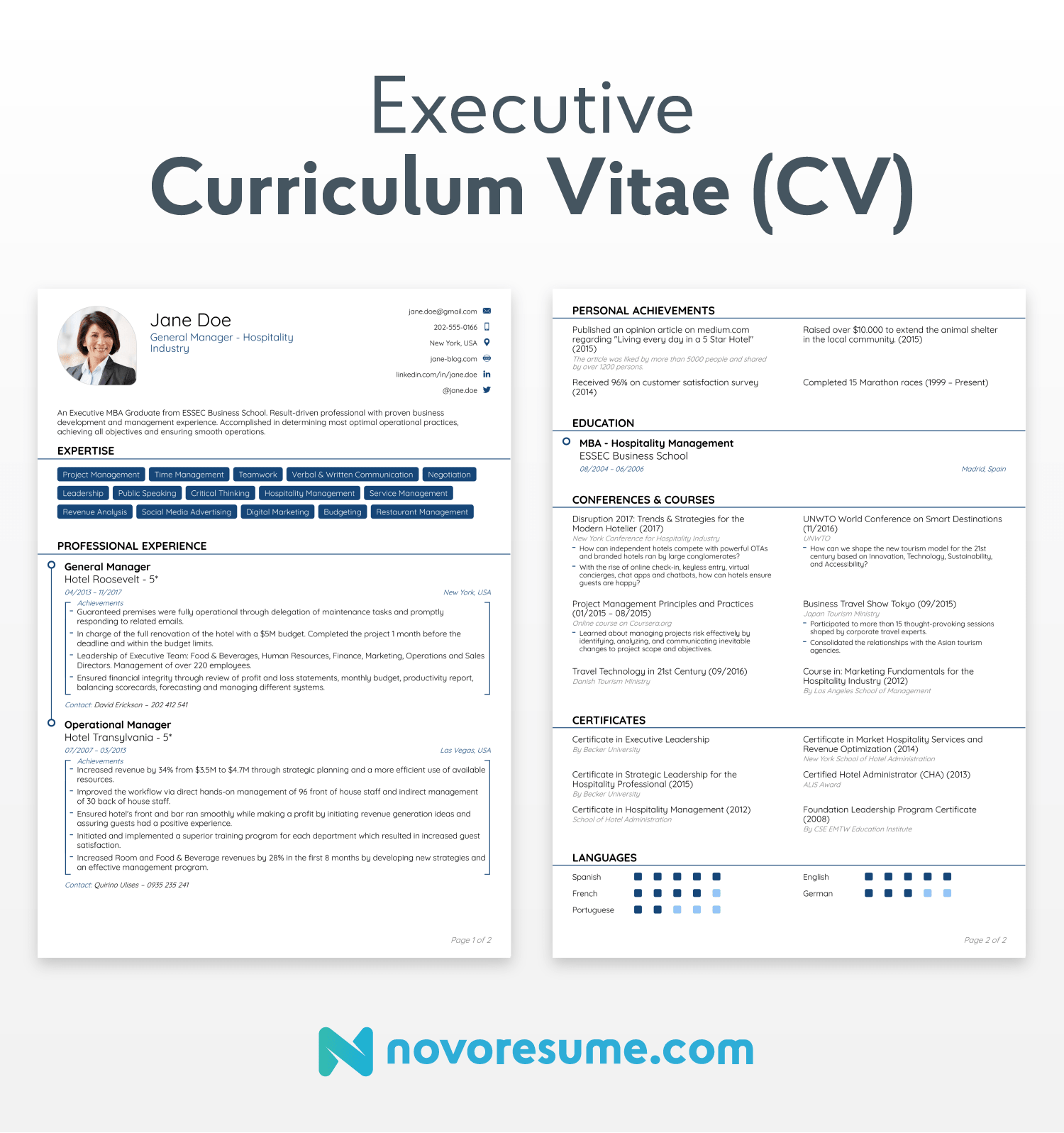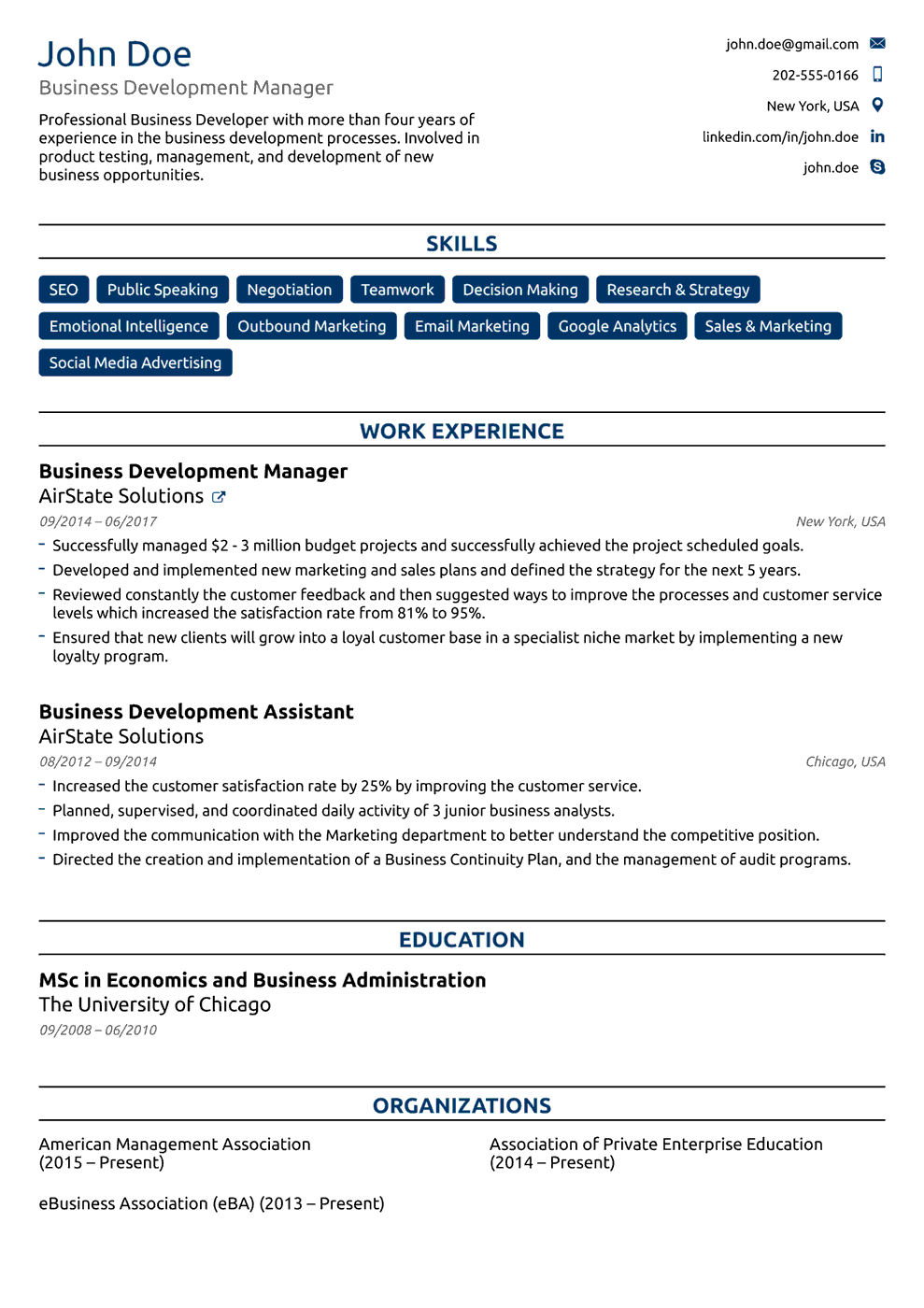A CV, or curriculum vitae, is a detailed, 1-2 page document that highlights your educational or career achievements and experiences.
You’re going to be asked to provide a CV when applying for jobs in the EU, or if you’re applying in the academic field in the USA.
As far as terminology goes, that pretty much sums CVs up.
But what about in practice? What, exactly, does a CV look like? And how is it different from a resume? Well, we’re about to teach you just that!
- CV vs Resume - What’s the Difference?
- How to Write a CV (That Gets You The job)?
- 4 Free CV Templates (You Can Steal)
So, let’s get started:
CV vs Resume - What’s the Difference?
The difference between the CV and resume is a source for a lot of confusion. Here’s why:
In the EU, the words CV and resume mean exactly the same thing - a 1-2 page career summary document that’s used for job-search. The two words are usually used interchangeably, and it’s known that they both refer to the same thing.
In the USA, on the other hand, the curriculum vitae is a very long document (as many pages as needed) that summarizes everything you’ve ever done in your career. It’s used specifically to apply for positions in academia.
For the sake of this article, we’re going to be specifically talking about the European CV (as in, American Resume).
How to Write a CV (That Gets You The job)?
Before getting into how we have to first cover the what.
What does a CV consist of?
There really is no strict rule for that. It all depends on your experience and the position you are applying for. There are, however, some sections that are there to stay no matter what.
Every CV must include the following:
- Contact Information
- CV Summary or Objective
- Work Experience
- Education
- Skills
Depending on your profile, you can also include the following sections:
- Certificates and Awards
- Volunteer Experience
- Personal Projects
- Languages
In this article, we’re going to walk you through each of the sections we just mentioned and teach you how to include them in your CV the right way.
But first, let’s talk basics:
How to Format Your CV
When it comes to layout, most choices come down to preference. How you want your CV to look and how you want the information to be organized.
When making these decisions, keep these tips in mind:
- Stick to one page. No recruiter has time to go over more than that. Unless you have a very extensive work history that needs additional space, one page should be enough.
- Keep it consistent. Use the same colors, the right font, and font size for every section and section header. You want your CV to have a clean, professional, and organized look. (So, no comic sans for you.)
- Get the spacing right. There should be enough space between lines and sections so that everything is distinctive and easy on the eyes. Be careful of the other extreme, however. Wide margins and too many spaces might leave your CV looking weird.
- Save it in the right format. Some companies might specifically ask you to send them a .docx file. If they don’t, we’d recommend saving your CV as a PDF. This will make sure the formatting remains intact and your CV has a higher chance of getting past Applicant Tracking Systems.
And yeah, we know - following all these formatting and layout rules can be a serious pain. It can take hours to just format your CV before you can even start with the contents.
Want to skip ahead, and start with a compelling CV right off the bat? Use a Novoresume template!
Our templates were created in collaboration with professional recruiters, ensuring that the CVs are easy to read and scan.
Want to give it a go?

#1. Contact Information in a CV
You can’t really get a job if the recruiter can’t call you back to let you know the position is yours, right?
It’s crucial that you enter your contact information correctly and provide the recruiter with at least two ways of reaching back to you.
The must-have information for your CV consists of:
- First name and Last name.
- Phone number
- Email address
- Professional title
- Location
- Relevant social media (Optional)
With the right formatting, this is what the contact information section should look like:

All information should be up to date and professional.
This means no funny, confusing email address and no buzzwords in your job title.
- Software Developer
- johndoe@gmail.com
- Coding Wizard
- joethewizard@gmail.com
- When it comes to your location, just mention the city/country you’re based in. No need to mention your exact address. The recruiter wants to know if you’re in the same area as the company, or are going to need to relocate for the job.
#2. CV Summary or Objective
On average, recruiters only spend about 7 seconds going over each CV before deciding to toss it or consider it further.
How do you convince the recruiter you’re perfect for the job in just 7 seconds?
Use a CV summary or objective.
If you’re a recent graduate or you’re changing careers, a CV objective is what you should be using. It’s 2-3 sentences that give the recruiter a glimpse of your skills, motivation in the field, and career goals.
A good CV objective goes along these lines:
A creative and self-motivated marketing graduate looking for a full-time position as part of a marketing team. Practical experience in strategic marketing through internships and a part-time position.
On the other hand, if you’re an experienced professional with years in the industry, you should be using a CV summary.
As the name suggests, a CV summary is a snapshot of your professional history that highlights your experience and achievements in the field.
- Knowledgeable and thorough IT security specialist with 8+ years of experience with complex IT environments. Knowledge in scripting languages; eg. Python, PowerShell, etc, Cyber Threats Intelligence, and client and server OS security hardening. Extensive experience developing and monitoring security architectures of cloud-based systems for 8+ major companies.
#3. Work Experience in a CV
Your work experience section has a lot of influence when it comes to the recruiter’s final decision - it’s the best indicator of what you can do. What this section consists of can make or break your CV, so make sure you get everything right down to the details.
Each entry should consist of the following:
- Job title/position
- Company name
- Company location and description (Optional)
- Period of employment
- Achievements and responsibilities
When describing your work experiences, it’s best to focus on achievements instead of responsibilities.
You should show the recruiter you not only cover your responsibilities, but you also perform well.
When talking about these achievements, use numbers whenever possible. They make things more concrete and help get the point across.
IT Security Specialist
ABC Company
08/2015 - 10/2019
- Monitored and evaluated SIEM and other applications for compromise indicators
- Performed 1st level Malware/Breach/Compromise Analysis, detected 2 vulnerabilities in the system and made the necessary fixes to prevent data breaches
- Performed basic application administration for security-related monitoring and operations applications
- Created and/or updated security technical and architectural documentation
- Mentored, advised, and guided end-users as to security best practices
IT Security Specialist
ABC Company
08/2015 - 10/2019
- Advising users on cybersecurity
- Monitoring applications for indicators of compromise
The best way to talk about your work experiences is by using bullet points. Between 3-6 points are just right - less than that, it will be underwhelming. More than that, and you’ll have a hard time fitting your resume on 1 page.
#4. Education
Right after work experiences, education is another important section (especially if you’re a recent graduate writing a CV with no previous experience).
Again, following the reverse-chronological format, you’d be listing your most recent education first.
Each entry should consist of:
- Program name: BSc in Business Administration with a concentration in Marketing
- University Name: University of Chicago
- Years attended: 07/2017 - 05/2011
- GPA (if over 3.5): 3.8 GPA
- Honors (optional): Summa Cum Laude
- Academic Achievements (optional): Active member of University of Chicago Business Club and University of Chicago Sustainability Club
Alternatively, you can list courses you have taken that are relevant to the position you will be applying for.
Here’s what a well-formatted entry should look like:

If you want to get some more tips about the education section of your CV, check out our article on how to list education.
#5. Skills
Last but not least, the skills section of your CV requires some attention too.
There are two types of skills you can list.
Soft skills are related to your personality, communication, attitude, etc. They are attributes that help you adapt to a work environment and communicate with others. Examples of soft skills are teamwork, creativity, leadership, etc.
Hard skills (or technical skills) are things that you learn or are taught. They apply directly to your ability to complete a job. Knowledge in C# or PHP are examples of hard skills.
Now, soft skills like creativity or adaptability are in high demand by employers. You’d think that it’s a good idea to pack your skills section with soft skills, right?
Well, not exactly.
Most job-seekers use soft skills to fill up space on their CV, even if they don’t have the said skills. At this point, recruiters barely even look at soft skills on your CV. Rather, they evaluate this during interviews.
This doesn’t mean you should completely eliminate soft skills from your CV, though. We recommend mentioning soft skills when you have the experience to back them up.
E.g. only mention “Leadership” if you’ve worked as a manager in the past.
To be spot-on with the skills you are going to list, have a look at the job post itself. See what skills the recruiter is looking for and include just those in your CV. Use the exact wording they used, too. If the company is using an ATS, this will help you bypass it.
Still don’t know what skills to write on your CV? Get inspired from these 101+ essential skills that employers are looking for, sorted by industry.
#6. Other Sections
Have some extra space on your CV? No problem - you can fill it up with these sections:
#1. Certificates and Awards
These might be awards from competitions in college or certifications from online courses you attended.
In either case, they make your application look good and add to the idea that you are a high-achiever. That’s something no employer would complain about.
#2. Volunteer Experience
Have some volunteering experience?
It can be a great addition to your CV!
If it’s something related to the position you are applying for, volunteering experience shows your genuine interest in the industry. In addition, it can also count as work experience.
Even if the volunteering experience isn’t related to your career, it can still show that you’re the type of person who’s willing to put in the work for things they care about (which is a very desired trait in an employee).
As far as formatting goes, the volunteering section is pretty much the same as work experience and consists of the following:
- Name of the organization
- Location
- Time period
- Tasks and achievements
#3. Projects
These could be school-related projects (thesis, extracurricular activity, etc.) or personal initiatives (freelancing, side-gig, YouTube channel, blog, etc.).
Projects are extra-useful if you’re applying for your first job, as they show off your skills (even though you don’t have work experience).
Web Design Volunteer
Website for Drama Club
2019
- Designed and built a website for my university’s drama club using JavaScript
- Gathered, organized, and uploaded all previous performances of the club for easy access
- Maintained and updated the website throughout all 3 remaining years at the university.
#4. Languages
With current work environments becoming more and more international by the day, having multiple languages in your pocket gives you a competitive advantage.
When listing languages, we recommend mentioning your level of knowledge:
- Elementary Proficiency
- Limited Working Proficiency
- Professional Working Proficiency
- Full Professional Proficiency
- Native or Bilingual Proficiency
4 CV Templates to Get Inspiration From
Ready to start working on your CV?
You can get started by picking one of our CV templates here:
#1. College CV Template

Putting most of the focus on your education and skills, this CV template is perfect for recent graduates or anybody that doesn’t have a lot of experience.
#2. Creative CV Template

Including some pops of color and a two-column layout, this template is just perfect if you’re in the creative industry. Professional yet attention-grabbing.
#3. Executive CV Template

Being probably the go-to for most people, this template focuses on your extensive work experience.
#4. Modern CV Template

This template is as minimalistic as they come, yet manages to be modern and grab attention.
Key Takeaways
And that’s about it!
At this point, you should have a good idea of how to write an effective CV.
Now, let’s do a quick recap of the most important points we’ve covered:
- A CV is a detailed document that highlights your educational or career achievements and experiences. In Europe, it is the equivalent of a resume.
- You should create a one-page, minimalistic CV with consistent formatting. Want to skip this part? Just use a CV builder.
- Your CV should consist of the following sections: Contact information, CV summary or objective, work experience, education, and skills. If space allows, you can add certificates and awards, volunteer experience, personal projects, and languages.

